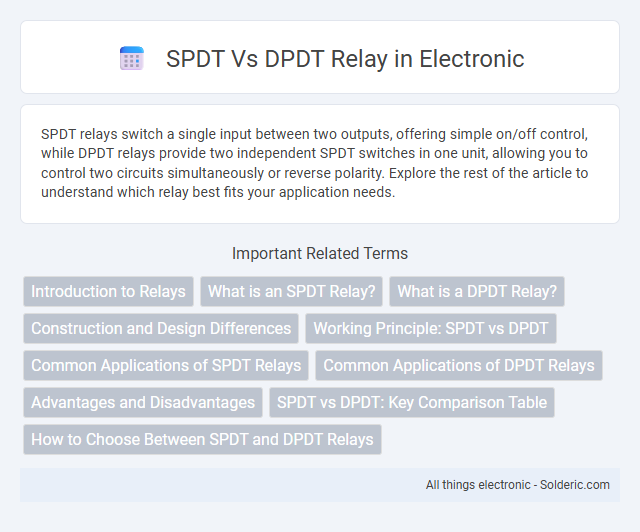SPDT relays switch a single input between two outputs, offering simple on/off control, while DPDT relays provide two independent SPDT switches in one unit, allowing you to control two circuits simultaneously or reverse polarity. Explore the rest of the article to understand which relay best fits your application needs.
Comparison Table
| Feature | SPDT Relay | DPDT Relay |
|---|---|---|
| Full Form | Single Pole Double Throw | Double Pole Double Throw |
| Number of Poles | 1 | 2 |
| Number of Throws | 2 | 2 |
| Contact Arrangement | One common terminal switches between two contacts | Two independent circuits switched simultaneously |
| Usage | Switching a single circuit | Switching two separate circuits |
| Control Complexity | Simple | More complex |
| Typical Applications | Basic switching, signal selection | Polarity reversal, dual circuit control |
| Size and Cost | Smaller, less expensive | Larger, more expensive |
Introduction to Relays
Relays are electrically operated switches used to control circuits by opening and closing contacts in another circuit. SPDT (Single Pole Double Throw) relays switch a single input to one of two outputs, providing simple on/off control or polarity reversal. DPDT (Double Pole Double Throw) relays control two independent circuits simultaneously, allowing for complex switching and circuit isolation.
What is an SPDT Relay?
An SPDT relay, or Single Pole Double Throw relay, is an electromechanical switch that controls one input circuit and connects it to one of two output circuits. It features three terminals: a common terminal, a normally closed (NC), and a normally open (NO) contact, enabling versatile switching applications in your electrical systems. SPDT relays are ideal for routing signals or power between two circuits without overlapping.
What is a DPDT Relay?
A DPDT relay, or Double Pole Double Throw relay, features two separate circuits with two switch positions each, enabling control of two independent circuits simultaneously. It offers versatile switching capabilities by allowing current to flow through multiple paths, making it ideal for applications requiring circuit isolation or polarity reversal. The DPDT relay typically operates with coil voltages ranging from 5V to 48V, supporting a wide range of electrical systems.
Construction and Design Differences
SPDT (Single Pole Double Throw) relays feature one input terminal connected to one of two output terminals, enabling a single circuit to switch between two paths. DPDT (Double Pole Double Throw) relays consist of two SPDT switches controlled simultaneously, allowing two separate circuits to be switched at once. The construction difference is primarily in the number of poles and contacts; SPDT has one pole with three contacts, while DPDT includes two poles, doubling the contacts and mechanical components for multi-circuit control.
Working Principle: SPDT vs DPDT
SPDT (Single Pole Double Throw) relays operate by switching one input contact between two output contacts, allowing a single circuit to be connected to either of two terminals. DPDT (Double Pole Double Throw) relays function similarly but control two independent circuits simultaneously, each with a single pole that switches between two throws. Your choice between SPDT and DPDT depends on whether your application requires switching one or two separate circuits.
Common Applications of SPDT Relays
SPDT (Single Pole Double Throw) relays are commonly used in automotive circuits for switching between different power sources or loads, as well as in HVAC systems for controlling compressor and fan operations. These relays are also prevalent in industrial automation for motor control, signal routing, and safety interlocks due to their ability to redirect current between two outputs. SPDT relays provide efficient switching in telecommunication devices and home appliances, ensuring reliable operation with minimal circuitry complexity.
Common Applications of DPDT Relays
DPDT relays are commonly used in applications that require switching between two separate circuits or reversing motor direction, such as in H-bridge motor controllers and signal routing systems. They facilitate control of higher voltage or current loads with a single relay, making them ideal for industrial automation and complex electronic devices. Their ability to switch two circuits simultaneously enhances reliability in audio equipment and robotic control systems.
Advantages and Disadvantages
SPDT relays offer simplicity and lower cost, making them ideal for applications requiring a single-pole double-throw switch, while DPDT relays provide versatility by controlling two circuits simultaneously with dual poles. However, SPDT relays are limited in handling multiple circuits, whereas DPDT relays tend to be bulkier, more expensive, and consume more power. Your choice depends on the complexity of the circuit and budget constraints, balancing compactness against functionality.
SPDT vs DPDT: Key Comparison Table
The SPDT relay features a single pole with double throw contacts, enabling it to switch one circuit between two outputs, while the DPDT relay includes two poles with double throw contacts, allowing you to control two circuits simultaneously. SPDT relays typically handle lower power loads and simpler switching tasks, whereas DPDT relays are better suited for complex applications requiring switching of multiple circuits or reversing motor directions. Your choice between SPDT and DPDT relays depends on the number of circuits you need to switch and the complexity of your electrical control requirements.
How to Choose Between SPDT and DPDT Relays
Choosing between SPDT and DPDT relays depends on the required circuit complexity and switching needs; SPDT relays offer a single-pole, double-throw configuration ideal for simple ON/OFF control or selecting between two circuits. DPDT relays provide double-pole, double-throw capability, enabling simultaneous switching of two independent circuits, which is essential for applications requiring polarity reversal or controlling multiple loads. Evaluate load requirements, control logic, and wiring complexity to select the most efficient relay type for precise and reliable operation.
SPDT vs DPDT relay Infographic

 solderic.com
solderic.com